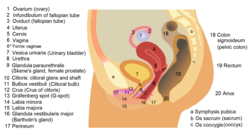
Urethral intercourse or coitus par urethra is sexual penetration of either the male or female urethra by a body part such as a penis or a finger. It differs from urethral sounding, the act of inserting a medical tool into the urethra (for both males and females) as a form of sexual or fetishistic activity. Though, urethral intercourse is a possibility of manual sex for heterosexual couples too (via the female inserting a finger into the male's urethra).
Contents
The untrained insertion of foreign bodies into the urethra carries a significant risk that subsequent medical attention may be required. Documented cases of urethral intercourse appear to have occurred between heterosexual couples; a survey of the global medical literature available in 1965 reported accounts of thirteen separate cases. [1] By 2014, 26 cases had been documented in the medical literature, many in people with Müllerian dysgenesis who were engaging in urethral intercourse unknowingly. [2] However, the stretching of the urethra required by this form of intercourse has also reportedly resulted in a complete and permanent loss of urethral sphincter control (urinary incontinence); furthermore such intercourse presents a very high risk of bladder infection to the receptive partner. [2] It can also lead to permanent dilation of the urethra and incontinence during intercourse. Presenting symptoms of unintentional urethral intercourse include primary infertility, dyspareunia (pain during intercourse), and incontinence. [2] More serious consequences include evisceration via the urethra and bladder rupture. [2]